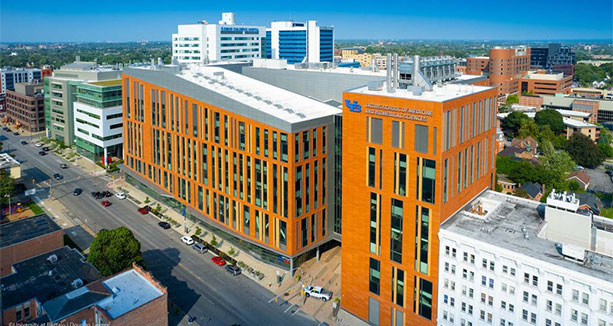
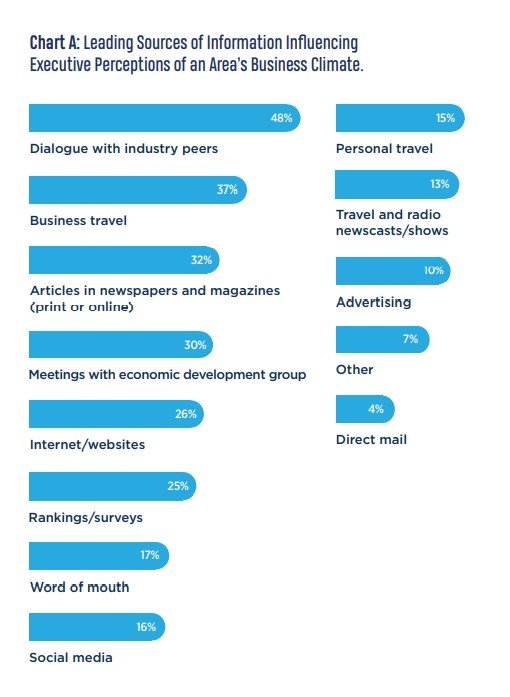 The term “newsjacking” is seemingly everywhere since Oxford Dictionary shortlisted it as one of its “words of the year” in 2017. But where does it come from, and how can it help economic development professionals get attention for their communities?
The term “newsjacking” is seemingly everywhere since Oxford Dictionary shortlisted it as one of its “words of the year” in 2017. But where does it come from, and how can it help economic development professionals get attention for their communities?
According to David Meerman Scott, the marketing strategist and author who coined the term, “Newsjacking is the art and science of injecting your ideas into a breaking news story, so you and your ideas get noticed.”
“In the space of a few short years, newsjacking has gone from an experimental technique to a staple in every social media-savvy marketing department’s arsenal,” Scott continues.
Effective newsjacking capitalizes on current events and breaking news in a way that gets a community, a business or a person into an existing national or regional news story. For example, many regions across North America received media coverage during the COVID-19 pandemic for ways they were managing the crisis. News stories Violet PR pitched during the spring of 2020 included a Kansas City-based whiskey distillery making hand sanitizer, the Pittsburgh International Airport’s hosting of a community food bank, and the Greater Topeka Partnership’s programs to help its restaurants and shops survive.
Recent examples of newsjacking opportunities include challenging topics such as #BlackLivesMatter and police brutality, the #MeToo movement and climate change. Last year’s Will Smith “slap” at the Oscars made international news and fostered a discussion about bullying and toxic masculinity. Lighter subjects ripe for newsjacking would include the White Lotus series on HBO Max inspiring people to take fancy vacations, and the popularity of Abbott Elementary, a sitcom about an underfunded Philadelphia school district, creating discussion about the state of America’s public school system. Both shows won big at the Golden Globe awards in early 2023.
An organization employing newsjacking is piggybacking off trending news and the large amount of discussion these events generate. When a story begins to trend, search traffic for keywords related to that story increases. If you get your content out quickly, news outlets may include it in their stories, link to it as a reference or reshare your social posts – yielding significant benefits, including driving traffic to your website and social media channels.
In the economic development sector, favorable media coverage will increase awareness of your community, which can help attract and retain businesses and talent, stimulate investment and attract partnerships.
Media coverage remains an important way to influence perceptions of a region: Development Counsellors International’s “Winning Strategies” survey of corporate executives and site selectors cites “articles in newspapers and magazines (both print and online)” as the third most influential factor influencing their perceptions of a place. Dialogue with industry peers and business travel are the top two influencers.
This article serves as a guide for determining what news is, how to stay informed, when and how to communicate news to reporters and other ways economic development organizations across North America have used newsjacking effectively.
What is News? Journalism 101
To understand how to utilize newsjacking as a marketing tool, economic development professionals must understand what makes something newsworthy.
According to the American Press Association (APA), “A good story is about something the audience decides is interesting or important. A great story often does both by using storytelling to make important news interesting.” In other words, anything can be news, but not everything is newsworthy. The APA describes journalism as “a process in which a reporter uses verification and storytelling to make a subject newsworthy.”
Journalists use “The Components of Newsworthiness,” a value model to evaluate the newsworthiness of potential stories. These news values were developed by professors Galtung and Ruge in 1973 and updated by Pamela Shoemaker in 1987. The more news values a story contains, the more likely you will see it prominently featured in mass media outlets. Some of these values are: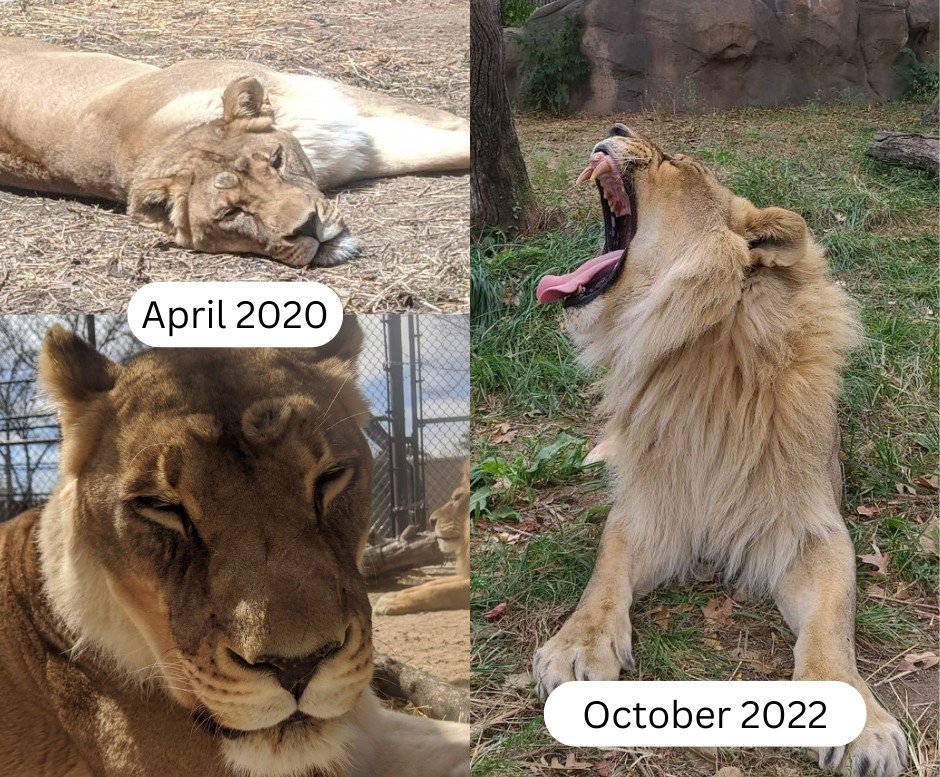
- Timeliness: How recently did the event occur? Today’s 24-hour news cycle means waiting too long is a missed opportunity. Often a complete news cycle takes place within a week — so if it’s something that happened a month ago or last year, it’s too late.
- Proximity: The closer an event takes place to the intended audience, the more important it is. Huge local or regional stories might not make the national news because they don’t reach a broader audience.
- Relevance: Is the news story relevant to a news outlet’s audience? A magazine read by biotechnology professionals contains different content than, say, a network news program.
- Impact: How many people will be affected by the event? Stories about natural disasters and climate change effects, a pandemic, mass flight cancellations and Congressional elections tend to (understandably) dominate national headlines.
- Predictability: Certain events, such as political elections or major sporting events like the Super Bowl or World Cup, happen on a predictable schedule. As the event draws closer, it typically gains news value.
- Controversy: Legal battles or decisions, political debates, corporate acquisitions, wars and other major cultural events make news. For example, the overturning of Roe v. Wade in the Dobbs v. Jackson Women’s Health Organization decision, the war in Ukraine and Elon Musk’s takeover of Twitter made significant news headlines in 2022.
- Human interest: If your story draws an emotional reaction, it has a human-interest element. Typically, reporters need to put a “face” to a story — this could be in the form of a CEO, political leader or celebrity. Also, journalists often conduct interviews with “people on the street” for stories relating to weather disasters or airline cancellations.
- Surprise: News stories with an element of surprise can create curiosity and go viral. A classic journalism aphorism about the difference between an everyday occurrence and news is referred to as a “man bites dog” story. One example is a story from the Topeka Zoo about a lioness who grew a mane, a trait associated with males, after her mate passed away. This unusual story was picked up by NPR and Popular Science, among others.
Staying Informed / Following News
You can’t leverage breaking or trending news unless you stay abreast of the latest happenings. Here are several ways to keep up:
- Read/follow the news daily. News aggregators, such as Google News, Feedly or News360, can help pull content together so you can stay up-to-date and find articles relevant to your industry. But don’t stop there: download news podcasts, watch nightly news programming and read long-form articles whenever possible. Try to read outlets from varying points of view, so both the New York Times and the Wall Street Journal, for example. Also, pay attention to what’s happening outside the business world; journalists often loop cultural references into their stories.
- Check social media frequently for trending topics and breaking news. For business news, LinkedIn has a “news feed” on the top right corner that is easy to check daily, and Twitter has a “what’s happening” trending topics list, broken down by national and state news.
- Set up Google Alerts. This free tool allows users to create custom searches based on specific words or phrases. Google will send a notification anytime it finds the search term in a news story. Set up alerts not only for your organization and spokespeople but for your top three competitors, as well as your most wanted target industries.
- Pay attention to what’s happening in your community and nationally. Be on the lookout for new developments being reported in the media on topics related to your region’s offerings. For example, if you are seeking to attract more robotics companies, make sure you know what’s happening in the industry and who the major players are. If you want to attract talent, read up on “best places” lists and check business publications for what’s motivating people to switch jobs.
- Plan for relevant events that will be widely discussed. These include annual festivals, major sporting events, national holidays or significant anniversaries. In those cases, you can create relevant content in advance and pitch and publish it just before the event occurs. Designations like Black History Month, Earth Day, June Pride Month, Giving Tuesday and Small Business Saturday can be hooks for related news from your community.
Next Steps in Effective Newsjacking
CONSIDER IF THE TRENDING NEWS IS RELEVANT TO YOUR INDUSTRY.
Newsjacking is an opportune strategy, and it’s easy to want to jump on a trending topic. However, before you move ahead, ask yourself these questions: Is there a legitimate tie-in to your region or organization? Does this news impact your stakeholders and community? Does your organization have experience, sources or information to share that is related to this news?
ACT FAST!
The key to a successful newsjacking effort is speed and messaging. Once you’ve decided that a newsjacking commentary is right for your organization and have spokespeople and background available, act quickly. Research from Google Trends found that the lifespan of news stories lasts about a week before the public moves on to the next “breaking” news.
PACKAGE YOUR STORY EFFECTIVELY.
Determine which media strategy is most effective for getting out your content. There are many ways to inject your ideas into a story. You can utilize standard tools such as social media, media pitch letters, packaged quotes and press releases to get coverage. Video and photos showing what’s happening are also important, as are links to data sources.
DEVELOP A PITCH.
An effective pitch should typically be just a few paragraphs, with bullet points, to grab a reporter’s attention. Reporters do not have time to read lengthy reports or documents, as they are bombarded with hundreds of emails and social media messages daily. Make sure your subject line is compelling and consider including a pre-prepared quote from your spokesperson and a link to images or video that a journalist on deadline can use.
IDENTIFY REPORTERS.
PR firms use tools like Cision, Meltwater and Muckrack to identify journalists. These are vast media databases that offer background on tens of thousands of working journalists at the click of a button. If you don’t have access to a sophisticated media database, you can also Google reporters covering the topic you are pitching and approach them via Twitter, LinkedIn, Instagram or Facebook. Many news organizations publish reporters’ emails on their websites as well.
How to Write a Press Release and Pitch
A press release communicates important and useful information to the press. Knowing how to write an effective press release is vital to gain media attention for your region or organization. The AP Stylebook is a writing style guide that provides fundamental guidelines for spelling, language, punctuation, usage and journalistic style, so press releases, pitches and other media communication should follow its guidelines.
COMPONENTS OF A PRESS RELEASE:
- Headline and supporting subheadline: Headlines are key to any story and, if written well, will entice reporters to want to learn more about a story. The subheadline gives a brief preview of the news story.
- The Five W’s: According to the “Five W’s” principle in journalism, a news story should contain the “Who,” “What,” “When,” “Where” and “Why.” A good press release must answer those five questions, so busy journalists need to do as little fact-finding as possible.
- Quotes: A good quote can be attention-grabbing and provide authority if coming from a spokesperson or official.
- Boilerplate: A brief description at the end of a press release that provides information about an organization or company, emphasizes an entity’s credibility and includes contact information.
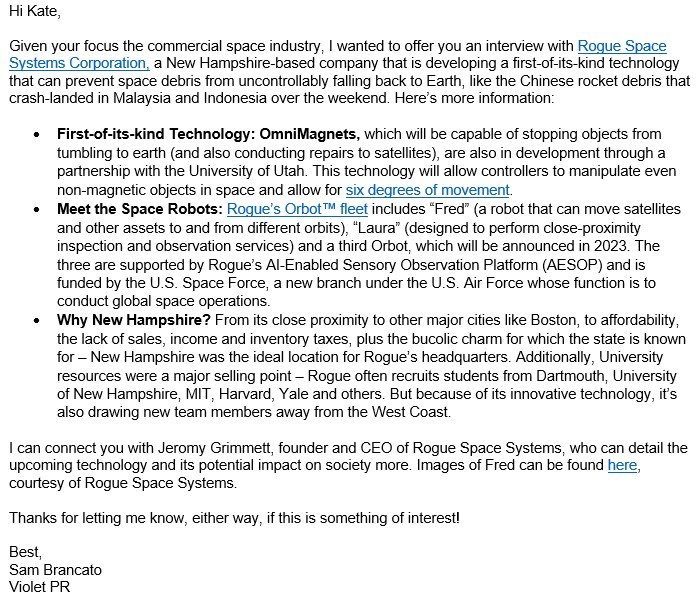
WRITING A PITCH:
A press release is only as good as your pitch. Reporters get potentially hundreds of messages in their inboxes daily, so making sure yours stands out is essential. Pitches should be clear, concise and to the point: here’s the news, why it matters, relevant images and sources for more information.
After fragments from a large Chinese rocket re-entered Earth’s atmosphere over the Indian Ocean in July 2022, Violet PR drafted a pitch highlighting Rogue Space Systems, a New Hampshire-based company developing technology that can prevent space debris from falling back to Earth. The pitch worked: the story was covered in outlets including Business Insider, MSN and Yahoo! News, reaching an audience of 4.97 billion people.
Additional Ways to Get Your Message Out
THOUGHT LEADERSHIP
You can also position your spokesperson as a thought leader on a trending or relevant topic by having them author an article for a trade publication or LinkedIn.
The New Hampshire Department of Business and Economic Affairs (BEA) has seen success using this tactic for Commissioner Taylor Caswell. When Smart Asset’s annual publication, “Where Millennials Are Moving,” listed New Hampshire among the top 10 states where millennials are relocating, Caswell published an article on LinkedIn and regional publications to amplify the ranking.
Tracey Hyatt Bosman, managing director of Biggins Lacy Shapiro & Company, one of the largest specialty site selection and incentives advisory consulting firms in North America, posted a series of articles tracking various right-to-work laws across the U.S., and the impact of these laws on site selection. The Wall Street Journal paid attention and quoted Hyatt Bosman in its opinion piece titled, “Right-to-Work Zones in Deep-Blue Illinois?”
CREATING A NEWS SITE
Organizations have increasingly launched in-house news sites to take control of their media coverage, particularly in communities where traditional media outlets have shrunk in size or been eliminated altogether. The Greater Oklahoma City Chamber launched VeloCityOKC in 2018 to highlight local businesses, economic news, newsmakers, business events and more. VeloCityOKC’s news coverage is often picked up by other news outlets in Oklahoma, helping amplify the region’s business successes.
Pittsburgh International Airport established Blue Sky News in 2019 as a news service for the airport, and it currently has more than 10,000 subscribers. The news site is run by former journalists and editors, and regional and aviation trade publications frequently cite its stories.
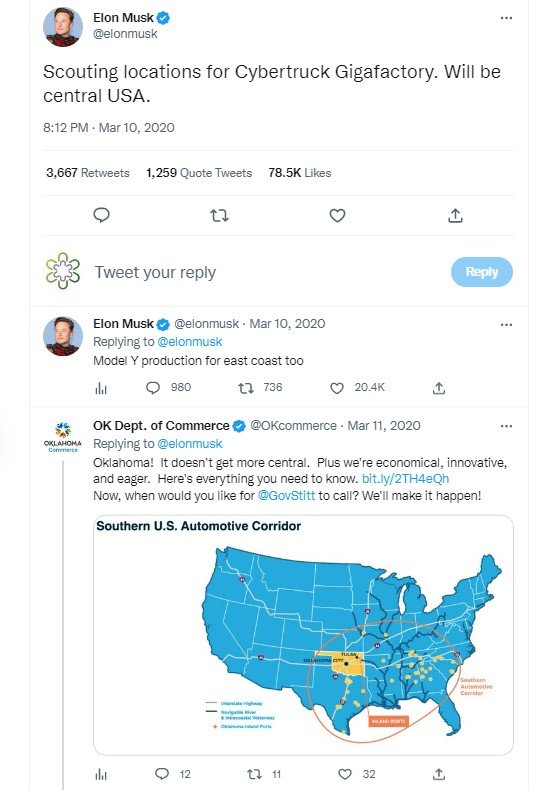
A Look at Successful Newsjacking by Economic Development Organizations
TULSA, OKLAHOMA
In 2020, Elon Musk announced on Twitter that he was looking for locations for Tesla’s Cybertruck Gigafactory. Oklahoma’s Department of Commerce quickly responded with a Tweet to Musk that said, “Oklahoma! It doesn’t get more central. Plus we’re economical, innovative, and eager. Here’s everything you need to know. Now, when would you like for @GovStitt to call? We’ll make it happen!”
Ultimately, the direct communication with Musk, and subsequent news coverage around Tesla’s site visit to Tulsa, helped position the region favorably in the site selection decision: Tulsa ultimately became one of two finalists. While Tesla ultimately chose Austin, Texas, for its Gigafactory, Tulsa positioned itself as an ideal destination for the electric vehicle industry. A year later, EV startup company Canoo announced that it would locate an electric vehicle manufacturing facility in Tulsa, creating more than 2,000 high-paying jobs.
BUFFALO, NEW YORK
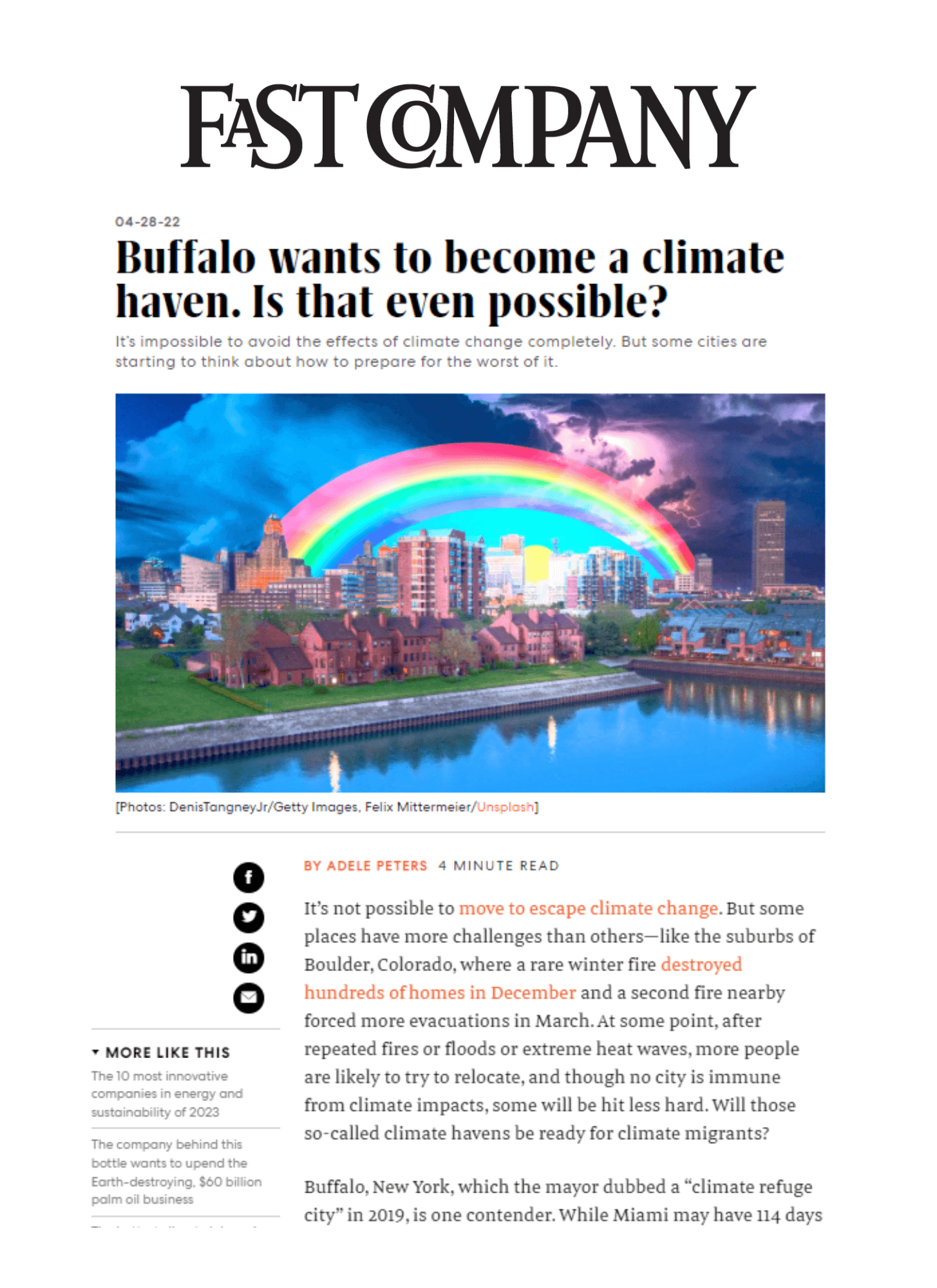 With climate change a frequent trending topic, Buffalo, New York, saw an opportunity to get itself into the conversation by positioning itself as a “climate change refuge.” With research from a Harvard University study and data compiled by Buffalo State College professor Stephen Vermette, Invest Buffalo Niagara launched a media campaign to take the focus off the city’s snowy and cold climate. The marketing positioned Buffalo as a city of the future due to its low risk of natural disasters, abundant fresh water and clean energy production.
With climate change a frequent trending topic, Buffalo, New York, saw an opportunity to get itself into the conversation by positioning itself as a “climate change refuge.” With research from a Harvard University study and data compiled by Buffalo State College professor Stephen Vermette, Invest Buffalo Niagara launched a media campaign to take the focus off the city’s snowy and cold climate. The marketing positioned Buffalo as a city of the future due to its low risk of natural disasters, abundant fresh water and clean energy production.
The PR campaign caught the attention of national media, including Fast Company, which published an article titled “Will Buffalo become a climate haven?” stating, “While Miami may have 114 days over 100 degrees Fahrenheit each year by the middle of the century, Buffalo might experience only eight extremely hot days a year. Buffalo is at low risk from hurricanes. There’s less risk of wildfire than in the Western U.S., and though summer droughts may increase, the city has an ample source of freshwater in Lake Erie.”
MIAMI, FLORIDA
Paying attention and engaging with his constituents helped Miami Mayor Francis Suarez bring significant economic growth to the city.
In December 2020, a Miami business owner used Twitter to suggest turning Miami into a tech hub. Mayor Suarez saw the Tweet and promptly responded, “How can I help?” His response generated 2.3 million organic impressions and became a very effective recruiting pitch — tech companies from Silicon Valley and New York have since relocated to Miami.
Suarez followed through by keeping up the engagement, often publicly welcoming new business leaders to Miami, who, in turn, tweeted about the benefits of relocating to Miami. Suarez had been positioning Miami as an ideal tech hub for more than a decade, but it was his effective newsjacking that set the plan into motion. The Tweet continued to generate favorable news coverage into 2021, with a news story by Quartz titled, “Miami’s tech boom started with a tweet but is sustained by more than hype.”
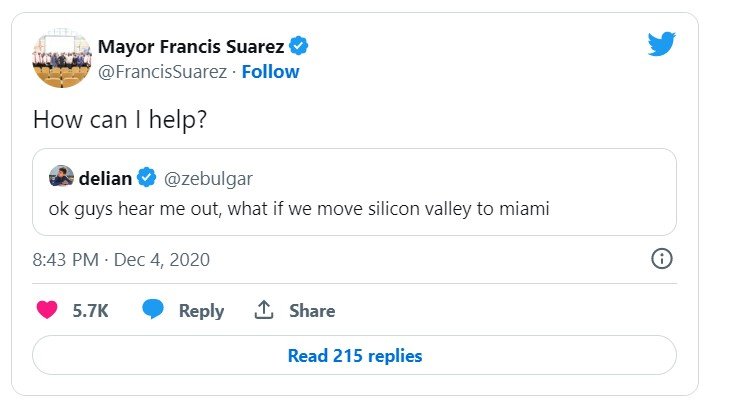
KANSAS CITY
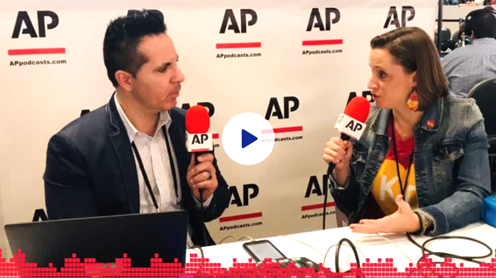 Acting on a Tweet also sparked an effective campaign for the Kansas City Area Development Council (KCADC) during what was the Kansas City Chiefs’ first Super Bowl appearance in 50 years in 2020. BJ Kissel, the official reporter for the Chiefs at the time, made a request on Twitter for pictures of the best watch parties at bars around the country. KCADC jumped on the opportunity and sent the reporter images of its ambassadors from Kansas City that were attending watch parties at Chiefs bars across the U.S.
Acting on a Tweet also sparked an effective campaign for the Kansas City Area Development Council (KCADC) during what was the Kansas City Chiefs’ first Super Bowl appearance in 50 years in 2020. BJ Kissel, the official reporter for the Chiefs at the time, made a request on Twitter for pictures of the best watch parties at bars around the country. KCADC jumped on the opportunity and sent the reporter images of its ambassadors from Kansas City that were attending watch parties at Chiefs bars across the U.S.
And on the ground in Miami, Kansas City’s PR team arranged for interviews outside the Super Bowl with Kansas City leaders including Kansas City, Missouri, Mayor Quinton Lucas and Ashlie Hand of the KDADC. Kansas City ambassadors also held up KC Heartland signs that were featured in various broadcasts about the Super Bowl on CNN, the NFL Network and Fox Sports.
Challenges of Media Engagement
Media engagement, in any form, always carries some risk. Determining whether you have a legitimate tie to a particular story and whether it is one to weigh in on should involve thoughtful consideration. Consider avoiding newsjacking news stories with negative connotations or sensitive subject matter. Short-sighted attempts to inject your region or organization into events, especially tragic occurrences, to attract attention can be damaging. Several large retail companies learned the hard way when they received negative backlash for their insensitive newsjacking efforts to use Hurricane Sandy in 2012 to sell their brands.
On the other hand, using newsjacking to promote how your organization can offer assistance during a crisis can be an effective strategy. The New Jersey Business Action Center (NJBAC), a business advocacy team for the state of New Jersey, ramped up its marketing efforts during and post-pandemic to promote how the organization could assist small businesses with COVID-19 financial assistance programs. Similarly, the Pittsburgh International Airport CEO talked openly about pandemic-related challenges the airport was facing in news outlets, including Cheddar, while including positive messaging about the airport’s new cleaning protocols and commitment to keeping staff employed.

Keep in mind that effective newsjacking can be time-intensive and resource-heavy and it’s only one aspect of a successful communications strategy.
For smaller organizations on limited budgets, interns can help monitor news and social media, while an organization’s marketing director or CEO can establish relationships with local reporters and any national stringers that are located in your market. This could include a business journal, daily newspaper, Associated Press bureau or national broadcast affiliate. Local stories often can be picked up by national media, so starting there makes sense. It’s also critical that spokespeople have media training so they are ready when opportunities arise; you can find local experts (often former broadcast journalists) with this experience.
On the national front, it can be challenging to pitch hundreds or thousands of reporters if you are a small organization. Economic development organizations with more resources can consider working with a PR agency or outside consultant with resources and established media relationships.
Conclusion
Newsjacking capitalizes on current events and news in a way that gets a region, organization or person media coverage. If done swiftly and correctly, it can be a highly effective strategy for economic development organizations to increase community awareness and attract and retain businesses and talent.